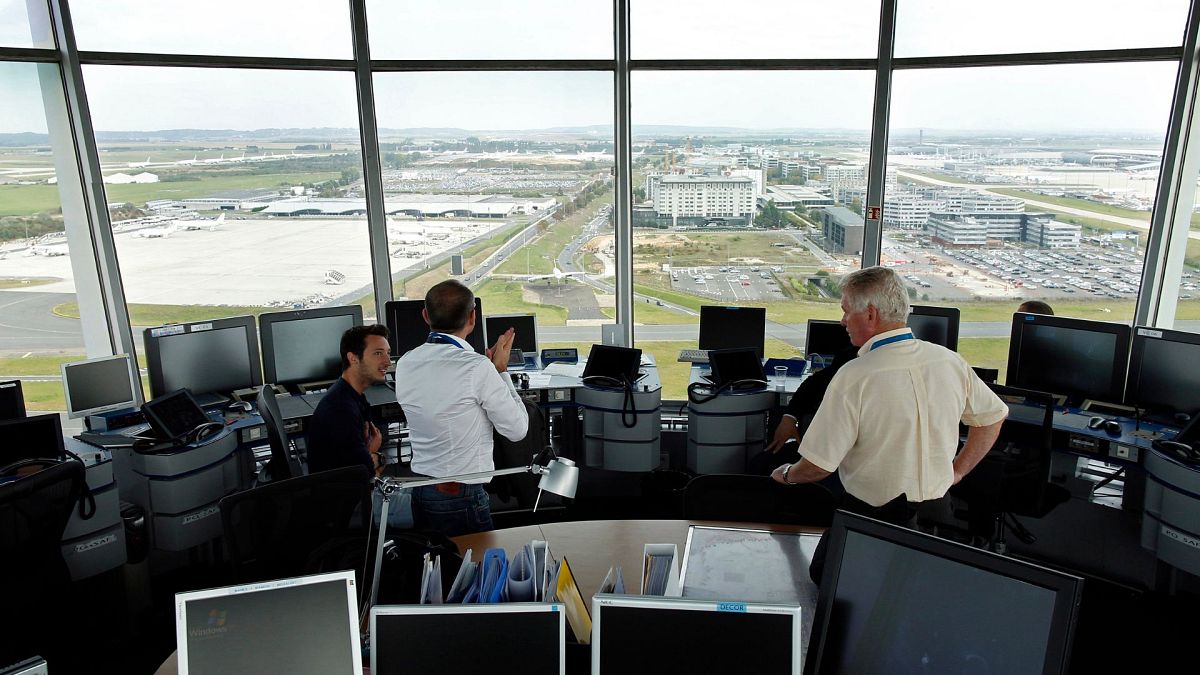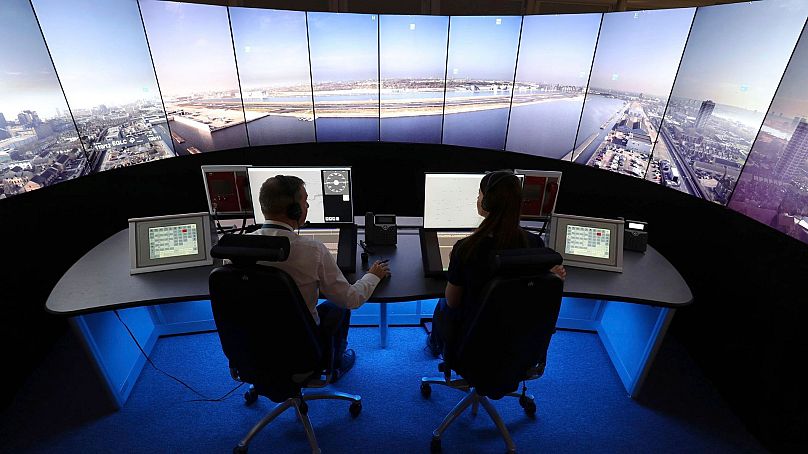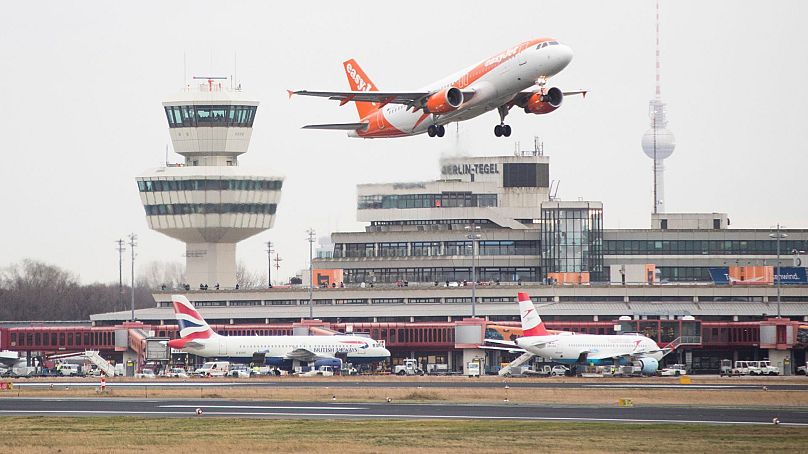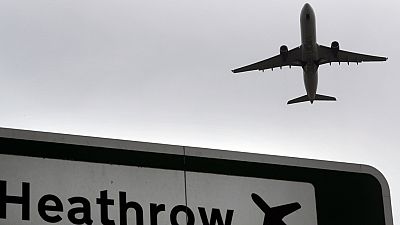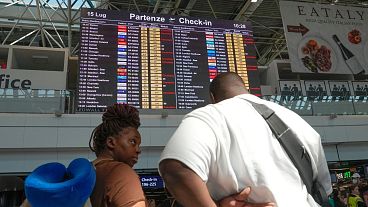2023 has been a disruptive year for air traffic control in Europe. Why is this, and will it continue into 2024?
We all appreciate the pilots who fly us safely to our destination. Some of us even clap for them on landing - much to the chagrin of fellow travellers.
But what about the hidden heroes guiding our safe path through the skies?
Air traffic control officers do the difficult job of keeping planes from crashing. Yet most of us had never even heard of them until they sparked travel chaos by going on strike this year.
When you know what it takes to become an officer, and the high stakes nature of their job, it’s easier to understand their demands for good working conditions and pay.
So what exactly is air traffic control, how do you get a career in it, and why has it been linked to so much travel disruption over the past year?
To find out what’s really behind Europe’s air traffic control problems and what it will take to fix them, Euronews Travel spoke to industry bodies, union members and the European Commission.
What it takes to become an air traffic controller
Staff shortages drove much of this year’s airport disruption and strike action.
The pandemic is partly to blame. The financial strain, health restrictions, low air traffic and uncertainty it caused put training for many air traffic controllers on hold. Being able to manage lots of overlapping planes is a key part of the job - and that takes practise.
“Adequate on-the-job training was only possible again when traffic levels had increased sufficiently to create a challenging practice environment,” explains Johnny Pring, the manager of Europe policy and advocacy at CANSO (the Civil Air Navigation Services Organisation), a representative body of air traffic control providers.
It takes at least 2.5 years to train an air traffic control officer (ATCO).
Every controller goes through basic training, followed by specialised training in a specific expertise, such as Tower Control, Approach Surveillance or Area Control Surveillance. They must then progress to field training at the airfield they will eventually control.
Finally, they will complete on-the-job training with an ATCO who is qualified to provide it. At airports where traffic has seasonal peaks, simulators are used for training during less busy periods to help maintain competence.
As every airport varies in density and complexity, and part of the training is location specific, air traffic controllers cannot be easily transferred between different airports.
At Maastricht Airport’s Upper Area Control Centre (MUAC) in the Netherlands - one of the most complex and busiest in Europe - the training takes approximately three years, according to Eurocontrol, an international organisation that works to achieve safe and efficient air traffic management across Europe.
Strict regulations govern the whole process and mean that most parts of the training can only be led by qualified ATCs. This means there is limited capacity for training, and staff shortages squeeze this even further.
What is air traffic control, anyway?
Air traffic control helps aircraft to move safely and efficiently through the sky.
Controllers are in constant contact with pilots, giving them information and advice to make sure they take off and land safely and on time. They give the pilots permission to take off, approve the route they’ll take, and ensure that aircraft are kept a safe distance apart in the skies, tracking their progress as they go.
In the UK, aircraft in the airways system are handled by NATS (National Air Traffic Services) and overseen by the Civil Aviation Authority (CAA). Eurocontrol oversees air traffic management across the European Union.
Various Air Navigation Service Providers (ANSPs) - the employers of controllers - provide individual air traffic control at airports, which is specialised to each location. Controllers hand over to one another as an aircraft travels between different jurisdictions.
What’s behind the ATC strikes and why are some more disruptive than others?
From strikes to technical failures, it’s been a turbulent year for Europe’s air traffic controllers.
In spring, French air traffic controllers (ATCs) began a strike in solidarity against pension reforms. Then in September, London’s Gatwick Airport was forced to limit flights after its already depleted ATC team was struck with COVID-19.
At the time, easyJet chief executive Johan Lundgren blamed understaffing for the disruption, telling a British newspaper that the way the service is structured, run and regulated is in need of modernisation.
The problems show no sign of abating. Just last weekend, passengers at London’s Heathrow Airport faced delays and cancellations due to ATC staff shortages and strong winds. On the same day in France, ATC staff staged a walkout that lasted until Tuesday and led to further disruption for travellers.
So what’s with all the air traffic control strikes?
Why are air traffic controllers going on strike?
Firstly, the cost of living crisis has led workers in various sectors to strike over pay. Many ATC strikes have been called to demand wages that are in line with inflation.
Unions have also called for improved working conditions and support for providing a safe and efficient service for transport users - especially in light of persistent staff shortages.
Most recently, French ATCs have walked out over new legislation requiring them to register their intent to strike at least 48 hours in advance.
Tuesday’s action in France marked the 65th day of strikes by air traffic controllers since the start of the year.
French strikes are particularly disruptive as they also affect ‘overflights’ using French airspace.
“Countries have different approaches to how ATC strikes are regulated,” explains CANSO’s Pring.
“In certain countries (Italy, Greece and Spain), overflights are protected and the strikes only affect domestic traffic; in others, all flights are affected. This regulation is a matter for national governments.”
How is the pandemic still affecting Europe’s air traffic controllers?
The pandemic is beginning to feel like a distant memory. Flights in Europe are back to over 94 per cent of 2019 levels and tourism is booming. But for air traffic controllers, its legacy lives on.
ANSPs manage air traffic on behalf of companies or countries, and collect fees from airspace users. With flights grounded during COVID-19, their revenue plummeted. This forced many of them to make cost savings, such as cutting staff.
ANSPs operating under the Single European Sky (SES) - an EU initiative that seeks to improve their performance - are faced with further cost pressures. The SES sets targets for safety, environment, capacity and cost-efficiency.
While its 2023 assessment shows that Europe’s ANSPs met their cost-efficiency targets, it highlights that “for some Member States, achieving this was a result of not adequately investing in their post-pandemic capacity” - with knock-on effects for capacity targets. It is possible that this was a conscious choice to help cut costs in line with targets.
However, this is not the aim of the legislation.
Why are ANSPs so heavily regulated?
As IATA - the trade association for the world's airlines - explains, “Airports and air navigation services providers (ANSPs) are, for the most part, natural monopolies.” This means strong regulation is needed to ensure they do not raise their prices arbitrarily. It also aims to ensure they improve their services and maintain efficiency.
“In effect, the aim of the Single European Sky framework is to encourage monopolies to make the necessary investments with a view to being able to provide sufficient capacity and meet their performance targets,” explains a spokesperson for the European Commission.
“Such investments could include training and hiring of staff, upgrading to newer systems, rollout of new technologies, radars and so on.”
All stakeholders, including ANSPs, airlines and professional staff organisations, are consulted when setting the performance targets, they add, with differing views being taken into account.
In the UK, the Civil Aviation Authority (CAA) regulates air traffic control. It has recently approved a hike in prices to enable the provider to recover the costs lost during COVID-19. This will see the average cost of UK air traffic services rise by around £0.43 (€0.49) to around £2.08 (€2.39) per passenger per flight by 2027.
With air traffic now increasing, ANSPs are under pressure to hire more staff. However, since they are prevented from making a profit under rules established by the United Nations’ International Civil Aviation Organization (ICAO), more work doesn’t mean higher profits.
Why do ANSPs struggle with recruitment?
ANSPs have found it difficult to recruit new ATCOs - a challenge being faced by the whole aviation industry, according to Pring. This partly stems from air traffic control being a very niche industry that lacks access to top talent.
As most ANSPs are civil service organisations, their staff have certain job security rights and tend to work until retirement - which is capped at age 60 in many European countries due to the high-pressure nature of the roles.
As the demand for air traffic control really took off in the 1980s, many of the industry's experts are now coming to the end of their careers.
“Looking ahead, many ANSPs will have to address a retirement wave over the next decade,” adds Pring, which could worsen the situation significantly if action isn’t taken soon.
Currently, slow or non-replacement of ATCOs after retirement is common practice due to budget limitations.
How has the war in Ukraine impacted air traffic control?
Still reeling from the pandemic, ANSPs were hit with a new unknown: Russia’s invasion of Ukraine in February 2022.
“[This] has led to unprecedented [air] traffic volatility across Europe,” says Pring.
As a result ANSPs face uncertainty in long and short term planning. They have also encountered fresh challenges, as ATCs have to adapt to new traffic flows due to airspace closures resulting from the war.
The route extensions resulting from the closure of Ukrainian, Belarussian and Russian airspace to European traffic have also pushed ANSPs off course in meeting their Single European Sky environmental targets.
Air traffic delays fell in 2023
All this is not to say that the safety of air travel has been compromised in any way. As Pring notes, “Throughout the pandemic and the recovery, the ATM [air traffic management] industry continued to deliver safe and efficient flight operations.”
He even points to some operational successes in summer 2023. Air traffic flow management delays per flight fell by 18 per cent from 2.7 minutes per flight to 2.3 minutes, compared to 2022, excluding weather factors.
During NATO’s major military air exercise carried out over Germany in June, ANSPs successfully managed to keep travellers flying with fewer disruptions than expected. Only 12,474 flights were directly delayed out of a total 293,928, or 4 per cent of all flights.
So how can ANSPs build on this positive momentum?
How can Europe fix its air traffic control problems?
Lundgren may have been on the money when he said that the way air traffic control is structured, run and regulated is in need of modernisation.
“Dealing with the forecast increase in air traffic and the increasingly complex traffic mix will require investment in technology - increased digitalisation or automation - and people,” says Pring. “So this is a major focus for European ANSPs.”
In France, improvements are already in the pipeline. The country has scheduled a major overhaul of its air traffic control system in 2024, with thousands of flights to be cut while it is installed.
The EU’s Single European Sky targets also have a role to play.
“In setting the targets for the coming years, it is crucial to strike the right balance between cost efficiency (which determines what ANSPs can charge their airline customers) and capacity and environment,” says Pring.
“Only in this way will ANSPs have sufficient financial means to invest in the necessary resources - staff and infrastructure - to service their customers.”
This is not the only role the European Commission plays in helping with reforms.
“The Commission is working with Member States to reform ATCO training, which is unnecessarily long and complex,” says an EU spokesperson.
It also aims to improve network management and system resilience by “allowing ATCO mobility across borders and/or cross-border service provision to fill capacity gaps,” they add.
Such reforms to the Single European Sky would not only help to make service provision more efficient, flexible and scalable, but “should also help reduce flight cancellations in the event of strikes.”
Euronews Travel reached out to French union SNCTA, Belgium’s Union Syndicale Bruxelles (USB), and the UK’s GATCO and Prospect but did not hear back.
